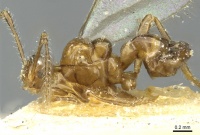Key to New World Pheidole Social Parasites
This key is based on: Wilson, E. O. 2003. Pheidole in the New World: A dominant, hyperdiverse ant genus. Harvard University Press, Cambridge, MA.
This is a queen based key.
You may also be interested in
1
- Queen antenna 10-segmented, with a 1-segmented club (parasite of P. nitidula of Argentina; placed provisionally in fallax group) . . . . . Pheidole argentina
- Antenna 9- to 12-segmented, with a 3-segmented club . . . . . 2
2
return to couplet #1
- Mandibles of queen reduced to tiny appendages, which are toothless, tapered to a blunt point at the end and only 0.06-0.07 mm long; male brachypterous and pupiform (parasite of P. nitidula of Argentina; placed provisionally in fallax group) . . . . . Pheidole acutidens
 Pheidole acutidens, Queen |
- Mandibles of queen normal in aspect . . . . . 3
3
return to couplet #2
- Sides of postpetiole expanded into hornlike extensions that make the postpetiole as a whole 3X broader than the petiole when viewed from above (parasite of P. ceres in Colorado; placed in pilifera group) . . . . . Pheidole elecebra
 Pheidole elecebra, Queen |
- Postpetiole normal in aspect, only 2X broader than petiole or less . . . . . 4
4
return to couplet #3
- Occipital corners of queen's head angulate (parasite of P. pilifera in Colorado, Nebraska, and Nevada; placed provisionally in pilifera group); small numbers of parasite minors and majors sometimes appear among host workers . . . . . Pheidole inquilina
 Pheidole inquilina, Queen |
- Occipital corners of queen's head smoothly rounded . . . . . 5
5
return to couplet #4
- Petiolar node in side view angulate at summit, its sides foveolate, crossed by longitudinal carinulae, and opaque (parasite of P. obscurior in Argentina; placed in fallax group) . . . . . Pheidole kusnezovi
- Petiolar node in side view angulate at summit, its sides smooth and shining (likely parasite of P. minutula in Guyana, either temporary or permanent, but status uncertain; placed inflavens group) . . . . . Pheidole microgyna







